About fifteen years ago a few mates and I bought cheap inflatable boats so that we could dodge the crowds around the local jetty and surrounding riverbank, launch our simple craft and paddle to the opposite bank. Although it was only twice the distance of a good cast away, we had the bank to ourselves and were fishing water that wasn’t anywhere near as pressured as the easily accessed side of the river. The result was a few fun and memorable trips, with plenty of nice flathead landed on soft plastics.
At the time I had a boat and a kayak, but there was something about the simplicity, portability and adventure element of our blow up craft, along with the ability to store it in a car boot in case the tides were right when we knocked off work – and so began my fascination with inflatable watercraft.
Since these early sessions I have followed the development of inflatable watercraft, from drift boats and float tubes, to an impressive new wave of inflatable kayaks that are making the most of developments in lightweight, durable and technical fibres and materials. There is a growing scene called pack rafting, combining hiking and exploration with inflatable craft that pack small enough to be added to your hiking pack and weigh as little as half a kilo! Kind of like my old inflatable boat from back in the day, except that there is no way I would take that $49.95 boat down the rapids that these guys ride!
A little while ago the subject of inflatable kayaks came up at the dinner table and a couple of weeks later our two-person Sportek KK2 kayak was being unpacked on the lounge room floor. We have other kayaks, so why did we buy an inflatable kayak? Our original plans were to use this vessel when we travel as it can be stored in a large plastic crate in the back of our vehicle when we travel locally and is quickly and easily unpacked and inflated should we be greeted by good weather or fishable water. It also weighs under 20kg and fits in a standard large suitcase, allowing it to accompany us on interstate adventures via plane. This has me dreaming about big Tassie bream, trout in the southern waters, the monster flatties of New South Wales and the coastline of WA. I just need to read up on the local regulations about cleaning fishing gear and watercraft, so as not to transfer any weed or pests from one waterway to another.
There are positives and negatives associated with anything, and inflatable watercraft are no exception. In terms of negatives the inflatable option does come with the responsibility of care in terms of handling, usage and storage that avoids puncture or damage to the material. They are not as durable as their solid cousins however developments in materials have made them more durable than the simple pool toys of old. Performance wise, inflatable craft are generally not as fast through the water and don’t track as well either, although quality inflatable models have greatly bridged this gap in terms of both speed and tracking. Inflatable craft often have a reduced payload for their size, but this will encourage you to keep it simple and leave some of that excess baggage at home. Attaching accessories such as sounders and rod holders can also be a little trickier, with Railblaza offering a solution via their RIBPort mount, designed for mounting accessories on inflatable craft.
It’s not all negative though. If you have limited space for storage then an inflatable kayak could be ideal. All you need is an area to wash it down and let it dry, and then it can be folded back into its bag and stored in a cupboard. Some models can even pack small enough to fit in a backpack. Your inflatable kayak also fits in a car boot, allowing it to tag along on your adventures… just in case an opportunity arises to wet a line. You don’t need to worry about roof racks, tying the kayak down or leaving it unattended on your vehicle. There’s also the opportunity to book an extra bag, load it in a suitcase and take it further afield.
Inflatable kayaks are generally lighter, with one-person models often weighing around 11kg, making them easy to throw on the shoulder and carry from pool to pool when exploring rivers and gorge country that can be difficult or even impossible to explore on foot or in larger craft, which makes them ideal if there is rugged terrain between you and your proposed launch site.
I was also impressed with how quickly and easily inflatable craft set up and pack up. Our KK2 set up in ten minutes, with forty or so pumps of the dual action hand pump per side chamber, a few more for the floor chamber and we were away. When it came to packing up, we simply opened the three valves and within seconds the kayak was deflated and ready to be folded up, loaded in the plastic crate and loaded back into the car. We were packed up and on our way home in minutes.
It’s a good idea to inflate your kayak at home first, giving you the opportunity to decide where you will be storing and attaching the gear you want to carry with you. Take the time to think about landing and handling fish also. Will you release them beside the kayak, bring them in with a net or lip grips, does the kayak have a skirt or front work area to rest them on or do you need a towel or container to put them in, and finally where will you store them if taking home a feed.
Along with your usual kit and safety gear it is worth taking your repair kit with you just in case, along with a few zip ties, cloth tape and a couple of occy straps, items that I carry with me in any yak that I am travelling in.
Kayak selection is a personal choice and only you can decide which kayak best suits your needs. Many kayak anglers have found that they need a few kayaks in their fleet to cover different applications and environments, such as small creek work, estuary fishing and long distance offshore missions, or perhaps even camping and touring adventures. If you decide that an inflatable kayak might suit your needs make sure you do your research as there are a wide range of models available to suit many different applications, from white water to touring, designed for solo and tandem paddlers. Paddle a friends if you have the opportunity or keep an eye out for demo days, and stick with a quality, reputable brand such as Hobie, Sportek, Bic, Sevylor, Sea Eagle and AdvancedFrame, to name a few.
Our Sportek KK2 is perfect for flat-water paddling and was quick and easy to set up and pack up, stable, tracked and paddled well, and comfortable. Over time I will customise our storage and fit out to further suit our requirements. With a little co-ordination we had our tandem paddling down pat, but the KK2 also handled well when paddled solo from the rear seat with additional gear and an Evakool 20L icebox stored in the front seating area. I look forward to future inflatable adventures and am now thinking that I need to keep an eye out for the next Hobie demo day to give their new pedal inflatable options a test drive…
See you on the water!
Reads: 3773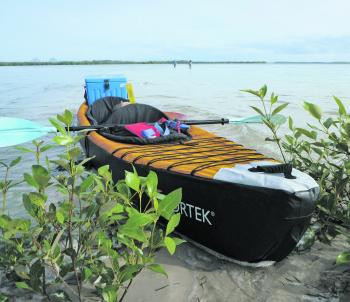
The inflatable is ideal for accessing fishy water.
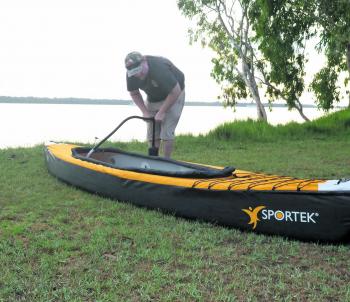
A few minutes with the pump and we're ready for action.
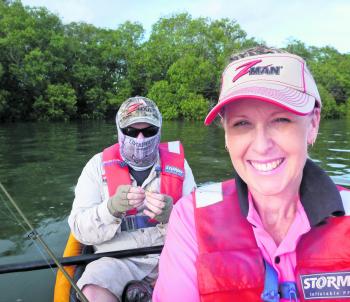
Quality inflatable crafts are stable and comfortable.

This tandem also paddles well as a solo option.
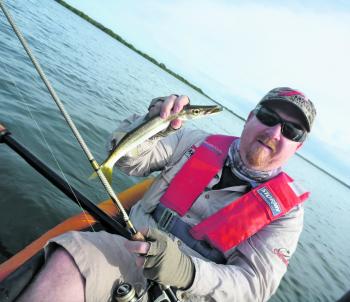
Not the ideal way to christen the KK2, a yellowtail pike, but better than no bites!
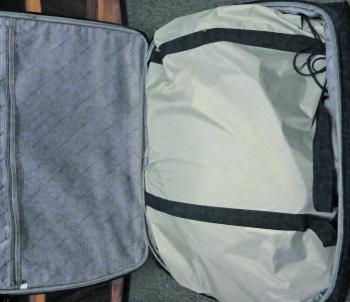
Under 20kg and fits neatly in a large suitcase for your fishing missions.
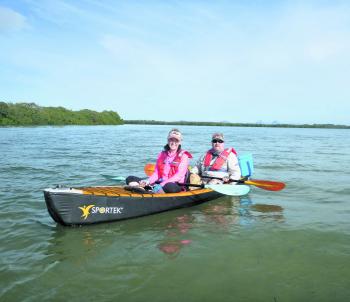
The inflatable option is an awesome one!




